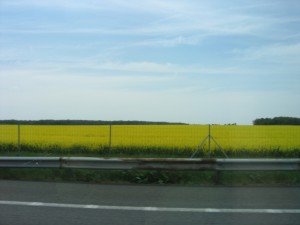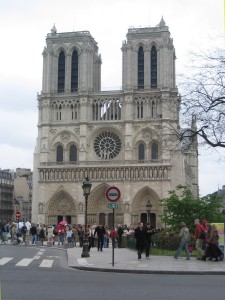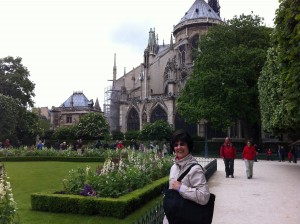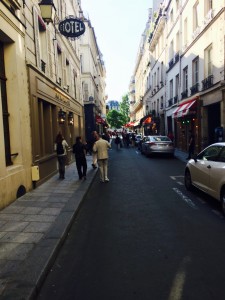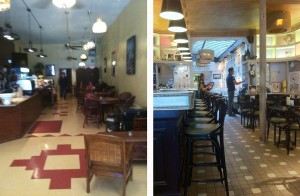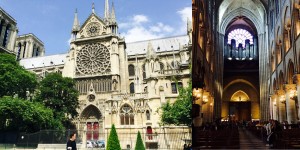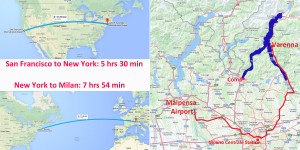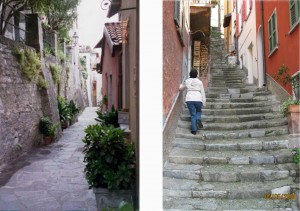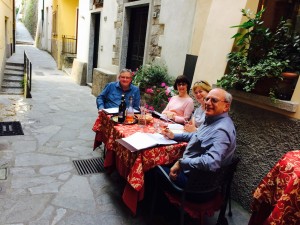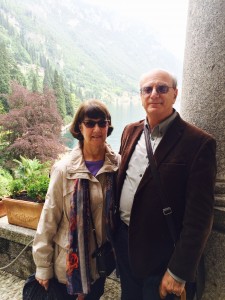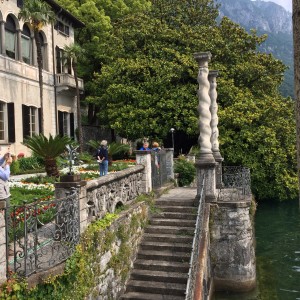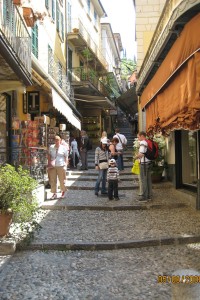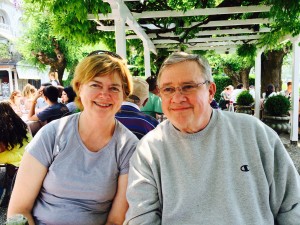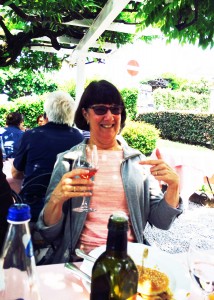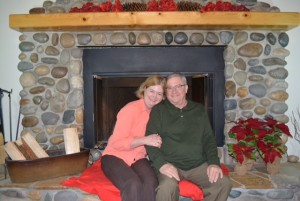Archive for D&G in Europe 2015
A Monday Afternoon On a Train to Paris
“You get old and you realize
there are no answers,
just stories.”
— Garrison Keillor
=================================================
We have ridden quite a few trains in Europe over the years — short rides between Milano and Varenna, longer rides across Italy, France, Austria. Overall, they have been smooth, comfortable, and convenient experiences. Some have provided stunning views of colorful, expansive countryside. Occasionally, they offered interesting conversations with fascinating people (take a look at one: https://convivio-online.net/?p=1073).
Our trip to Europe this past May/June included three. The first was a pleasant, five-hour ride from Varenna on Lake Como to Antibes at the tip of the French Riviera. The third was a swift, luxurious swoop to London under the English Channel on the Eurostar. In between those, we expected the most interesting part of our second high-speed train ride to be the swaths of bright yellow colza that carpet the three-hour ride from Avignon to Paris.
Instead, it turned out to be a dark page from the hard news stories that we hear nearly every day.
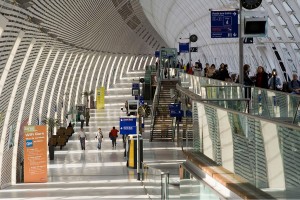 I suppose we could have taken it as a warning sign when we had an unusually difficult time finding the right platform at the Avignon train station. The uniformed attendant we asked to help us find Platform Z dismissed us with a wave and a bored mumble: “Platform Z is the last one” as he walked away to do something more important. Finally, a gentleman in a suit confirmed that we had found the right one.
I suppose we could have taken it as a warning sign when we had an unusually difficult time finding the right platform at the Avignon train station. The uniformed attendant we asked to help us find Platform Z dismissed us with a wave and a bored mumble: “Platform Z is the last one” as he walked away to do something more important. Finally, a gentleman in a suit confirmed that we had found the right one.
So, we found our seats and sped along, passing a pleasant hour enjoying the scenery and talking to a businessman across the aisle who appreciated the on-time reputation of the TGV train service, giving him confidence that he would be able to make the tight connection to the next train so he could be on time for his meeting.
At what seemed to be about half way to Paris, quite in the middle of nowhere, the train slowed to a stop at a concrete facility — not really a station, just a place with flat surface beside the tracks and a sign that said, in English, “Check Point.”
After a minute or two, I began to notice out my window a collection of officers, wearing three different uniforms, assembling beside the train. They began boarding the train at the gap between our first-class car and the car ahead of us, climbing the stairs to the upper car. After a few minutes, a pair of them re-appeared, each gripping with both hands the arm of a short-haired, clean-shaven man, whom they removed from the train and escorted forward out of our sight. Then another pair, similarly escorting another young man, and another, and another, until after an hour or so, we had counted seven who had been removed in the same way. We didn’t see any struggle, as each of those who were being removed walked as directed, eyes straight ahead, while in the firm grip of a pair of large uniforms.
I remember being struck by the fact that no one in our car said a word, we all just watched in silent attention until the businessman across the aisle from me leaned over and murmured, “Libyans, I guess.”
The train slowly began to move until, after 100 yards or so, I heard an audible gasp from the people in our train car. I looked out the window and saw what they saw — about 200 or so men, like those seven we saw escorted from our train, were sitting cross-legged, a few yards apart, hands behind their backs, guarded by an ample number of heavily armed men in uniforms. I gasped myself, as we passed in silence.
After a while, conversations in our car agreed on an estimate of 250-300 individuals. It was stunning to think that so many had been removed from our train — the train we had searched for along the platforms of Avignon station in the bright sunshine of a Monday afternoon, on our way to Paris. The train was an hour late at Paris Nord train station, but we arrived by taxi at our hotel on Rue de Saint-Louis-en-l’ille well in time for dinner.![]()
Headlines Come to Life: This Week in the New York Times
Tourists Traveling Through Europe’s River of Migrants
150 Migrants Feared Dead after Boat Sinks Off Libya
Migrants Transiting Through Macedonia Jam Trains
Hundreds of Migrants Try to Cross English Channel on Trains
Britain and France to Announce Measures to Contain Migrant Crisis
Migrants Race North As Hungary Builds a Border Fence
Bodies of 71 Migrants Found In Truck In Austria
Epilogue
On our second day in Paris after the train ride from Avignon, we walked from our hotel on Rue de Saint-Louis-en-Ille, across the footbridge over the Seine to I’ille de Cité, to visit Notre Dame cathedral. We had been there before and, over the years, we’ve thought of it as one of the most serene places in Europe. We crossed the familiar garden, passed a student group rehearsing a dance performance of some kind, circled around to the front of the church, and stopped at the sight of something we hadn’t quite seen before. We had certainly seen security guards before, around major monuments in Europe, but this was different. Three soldiers — not security guards, but fully uniformed, helmeted, flak-vested, heavily armed members of the French military — were walking purposefully across the courtyard in front of the church, scrutinizing the hundreds of tourists standing in line to go through metal detectors. These two held automatic weapons ‘at the ready.’ A third soldier stood at a distance in the same pose, appearing to be watching out for the other two. We sat down on a bench and watched as two more armed soldiers turned the corner from behind the cathedral.
They looked familiar.
I didn’t photograph them, just as I had not photographed the soldiers I had seen on the train two days before — it somehow didn’t feel like a good idea at the moment.
Europe is changing. Perhaps we are the last to notice.
Click here to download a PDF of this article: ConVivio_Afternoon_train_to_Paris_Aug29_2015
Le Flaneur: Getting Lost, Artfully, Passionately, On Purpose
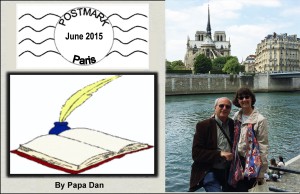 Paris (again and still) — Sitting thirty-some thousand feet above the Atlantic, on our way back from our visit to Varenna, Provence, Paris, and London with a glass of French wine in one hand and a fountain pen in the other, I’m considering what might be worth writing about. As always, one of our goals on this trip was to follow Rick Steves’ advice and become what he calls “a temporary local.” Not sure we did that –it’s hard to do that in a short time. But, I do think we met another goal in the ten days we spent in France: I had hoped once again to imitate one of the most enduring characters of French culture — a character held in admiration for centuries as the personification of all things French. The French have a name for this character: they call him le Flaneur.
Paris (again and still) — Sitting thirty-some thousand feet above the Atlantic, on our way back from our visit to Varenna, Provence, Paris, and London with a glass of French wine in one hand and a fountain pen in the other, I’m considering what might be worth writing about. As always, one of our goals on this trip was to follow Rick Steves’ advice and become what he calls “a temporary local.” Not sure we did that –it’s hard to do that in a short time. But, I do think we met another goal in the ten days we spent in France: I had hoped once again to imitate one of the most enduring characters of French culture — a character held in admiration for centuries as the personification of all things French. The French have a name for this character: they call him le Flaneur.
Le Flaneur has been a literary type since Charlies Baudelaire made this character famous in his poetry in the 1860s. Le Grand Dictionaire Universal in 1872 described Le Flaneur with equal parts curiosity and laziness, an artist-poet of the boulevards, parks, and cafés of Paris; “the closest thing to a sovereign the French should ever have,” he claimed. So, that’s the experience we wanted to have. For at least part of our time in France, I’d like to take a shot at being a Flaneur. So, who is he?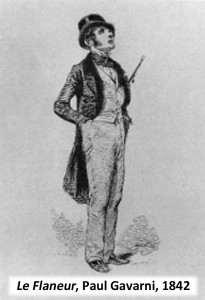
According to a long tradition of French writers, Le Flaneur is the perfect urban spectator, Baudelaire’s “gentleman stroller of the city streets,” engaged in the act of flanerié: aimless strolling, wandering to nowhere in particular, observing everything that presents itself, savoring the multiple flavors of the city. So passionate is his strolling that the act of flané has been described as “the opposite of doing nothing.” In short — it is the act of artfully, passionately getting lost on purpose.
You may ask — what kind of silly goal is that for an American with an Italian name? With all the beautiful and historic sights you can see in Paris, or in the wine-country of southern France, isn’t it sensible to use all of the tools at our disposal to make a schedule, get directions, and make sure we don’t miss a thing in the limited time we have? Well, you’re right – and we’ve done that before. In our first visit to France (Paris and Bourgogne in 2006), we tried to “cover” a lot of the touristy things — le Louvre, le Tour Eifel, le Jardin de Luxembourg, le Museé d’Orsay, Versailles, a boat ride down the Seine . . . But having done that, we set out this time, as we did during our visit to Paris and Giverney in 2012, explicitly to have an experience that doesn’t require (or even allow) a map. So, how does the traveler reconcile the goal of flanerié with the stream of guidebooks and websites full of maps and lists of “must see” things and places, all described with careful instructions on when to go there, how to get there, and what to do when you get there? Well, I’d like to describe a handful of small flanerié experiences we had, quite by accident, during our visits in Paris.
The Madmen of the Island: Le Fous de l’Ille
In 2012, we had the privilege of staying in Paris for nine days. That afforded us the luxury of walking out of our hotel on Rue Saint Louis en I’lle, stopping on the sidewalk, and taking some time to consider the first big decision of the day – should we turn left and cross the bridge toward I’lle de Cité or turn right toward unexplored territory. It seemed kind of obvious that turning left made the most sense. Turning left across the bridge would take us to Notre Dame cathedral. Sometimes there are musicians on the bridge. There is a beautiful park surrounding the cathedral where groups of artists often display their work. Sometimes there are interesting little boats floating down the Seine. And, of course, a couple of doors up from the bridge was the famous ice cream shop le Bertillon – and even though we had just finished breakfast, that would certainly be worthy of my attention.
So, we turned right.
Up the street from our Hotel de la Lutéce, there were a couple of souvenir shops, a French restaurant called Le Med, another hotel, some clothing stores, and some hidden treasures. Even though this is a crowded, narrow street, it hides some cavernous courtyards hidden behind some innocuous doorways –like this one:
[Click to get a look inside (after it loads). Private_entrance]
We may have gotten turned around, so to catch our bearings, we decided to turn left toward the river. (OK, on this little island every direction is ‘toward the river’). So, not having a destination, we drifted past an antique store. It was not especially noteworthy except that it had a graceful little perfume bottle in the window that got Gretta’s attention. Nothing else in the shop seemed particularly remarkable; so we moved on. Another block and we reached the river, turned right (why not?), and wandered past some ordinary-looking buildings. Then it got interesting. We passed a small bistro called Le Fous de L’Ille (translation: the Madmen of the Island). I looked in the window. It looked familiar. To my surprise, the interior layout was the same as the bistro in San Francisco owned by two of our sons – Ben and Will Sapone. It’s called The Flying Pig Bistro, in the Mission District. Very much the same:
- central front door between two large windows,
- alcoves behind the windows with barstools,
- inside, the bar down the left side,
- tables down the right side,
- art and interesting objects on display on the walls,
- kitchen in the back,
- turns out to have a reputation for good food and drink, and friendly service,
- This one has a “rooster” theme, ours back home has a “pig” theme.
Left: Flying Pig, 433 South Van Ness, San Francisco;
Right: Le Fous de L’Ille: 33, rue des Deux-Ponts, Paris
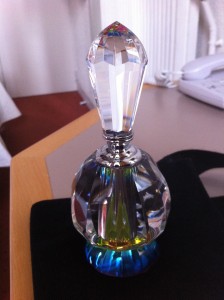 After the amazement wore off, we decided to find our way back to our hotel (or at least to Bertillon’s ice cream store). Gretta said, “What are the chances we could find that antique store? That perfume bottle is calling to me.” So, after a few rights and lefts, we found it and Gretta became the proud owner of a treasure that resides in our home today.
After the amazement wore off, we decided to find our way back to our hotel (or at least to Bertillon’s ice cream store). Gretta said, “What are the chances we could find that antique store? That perfume bottle is calling to me.” So, after a few rights and lefts, we found it and Gretta became the proud owner of a treasure that resides in our home today.
Le Flaneur Goes Left
The next day, walking out of our hotel after breakfast, we confronted the same critical decision – left or right? Today it’s left. Crossing the bridge to I’lle de Cité, there were still no musicians (a story for later). As the windows of Notre Dame cathedral sparkled in the morning sun, Gretta observed “We’ve seen the outside of the cathedral many times, but never the inside. What do you think?” So, we crossed the playground, passed a student group rehearsing a dance performance of some kind, circled around to the front of the church, and stopped at the sight of something we hadn’t quite seen before.
We had seen security guards around major monuments in Europe, but this was different. Three soldiers – not security guards, but fully uniformed, flak-vested, and heavily armed members of the French military – were walking purposefully across the courtyard in front of the church, scrutinizing the hundreds of tourists standing in line to go through the metal detectors. These two held automatic weapons ‘at the ready’ with fingers on the trigger. The third soldier stood at a distance in the same pose, appearing to be watching out for the other two. We had heard that security had been upgraded in Paris since the Charlie Hebdo terrorist attack and other deadly incidents, but for some reason this felt like ‘more’ than I expected. We sat on a bench and watched as two more soldiers turned the corner along the back of the cathedral. “They are serious. This is real.” We talked for a few minutes whether their presence made us feel safer or more at risk. I admit to a bit of sadness at the sight of them. I fully understood and appreciated their presence; but the scene felt more threatening than I had expected. We speculated that this was only the ‘presence’ we could see. There was undoubtedly more that we could not see. We have to arm ourselves this well to feel safe, even here at one of the more serene locations in Europe. Even le Flaneur acknowledges this truth in his observations. After hesitating awhile, we joined the others and entered the cathedral. A beautiful spot, inside and out. Apparently, well protected. Le duex Flaneurs take a taxi – to the Touleries where the afternoon calm and a Provençal Rosé took over.
[Click the link here —> Gretta_cheers_Paris (after it loads)]
Not All Taxis Are Alike
After a glass of rosé and a plate of frites, it’s time to go back “home” to our hotel le la Lutéce. Too far to walk. So the gentleman in the sidewalk, trained to sense when le Flaneur Americane needs a ride, said as we walked by, “Where you headed?”
“Rue de I’lle de Saint Louis,” I said in my best French accent.
“Twenty-five euro.”
After a few seconds of hesitation, he negotiated, “Twenty?”
“Twenty-five if the ride is smooth.” (As you can tell, I’m a tough negotiator.)
[Click on the two links below to take a ride with us – it may take a minute to load.]
A Musician on the Bridge
The bike taxi dropped us off on the Cité side of the bridge. In previous visits to Paris, this bridge had provided a venue for accordion players, saxophone players, trios, and quartets. Today, as we crossed to ‘our’ side of the bridge, we watched two policemen remove a guy who had set up what appeared to be a puppet show on the bridge and gesture to an accordion player that he needed to ‘move along.’ We watched as the policemen walked away, down the street beside the river, and finally out of sight. When they were gone, I greeted the accordion player and gestured toward the policemen and asked “Pourquoi?” “Three time they confiscate my accordion.” He shrugged, looked where they had gone, and brought his instrument into playing position. I handed him ten euro and he began playing. He smiled while he played, but every half-minute or so, he looked over his shoulder, apparently to see if the policemen had returned.
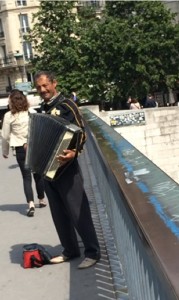 [Click on the link below for a few seconds of his music — it takes a minute to load]
[Click on the link below for a few seconds of his music — it takes a minute to load]
—> Our Musician_on the bridge,_looking
Later that afternoon, we asked why we hadn’t seen many musicians and a waiter at the sidewalk café at ‘our’ end of the bridge he told us “Paris now has laws against asking for money on the bridge.”
Oooooooops.
Finally: Two Lovers In Paris Tell Their Story
One day we wandered to a shady spot overlooking the Jardin de Luxembourg and found a spot with a grand view. Gretta was drawing the scene of Parisians enjoying one of their unique spots of shared public beauty and I was sitting with my notebook and my fountain pen, trying to look like a writer. An older couple walked up and leaned on the stone wall in front of us and we struck up a conversation. They showed an interest in what we were doing. “Gretta paints with watercolors,” I said, stating the obvious.
“And you are a writer?” she asked, pointing at my notebook.
“Oui,” I grinned.
In reply, she said, “Let me tell you a story.” Sensing an opportunity, I pushed the video record button on my iPhone, surreptitiously, I thought.
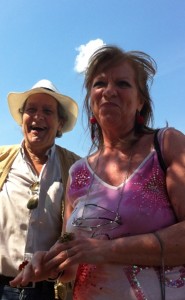 Turns out that they had met a very long time ago as teenagers at a dance, fell in love, but went the two separate ways that life took them — he to the army and a town near Rome, she to marriage and children 600 kilometers away. Decades later, now a widow, she told the story “of my first big love” to her grown son who suggested that she look him up on Facebook. She did. He immediately flew to Italy, and after much back and forth, now, here they are, in Paris together, where they belong. As she told her story, the gentleman and I exchanged glances at each other and at my iPhone and he nodded approval. When she was done, I gestured to the phone and said, “With your permission, I have been …” She interrupted, “Yes, I noticed. It’s a good story. Perhaps you’ll write it down.” We bid each other good day and they were off.
Turns out that they had met a very long time ago as teenagers at a dance, fell in love, but went the two separate ways that life took them — he to the army and a town near Rome, she to marriage and children 600 kilometers away. Decades later, now a widow, she told the story “of my first big love” to her grown son who suggested that she look him up on Facebook. She did. He immediately flew to Italy, and after much back and forth, now, here they are, in Paris together, where they belong. As she told her story, the gentleman and I exchanged glances at each other and at my iPhone and he nodded approval. When she was done, I gestured to the phone and said, “With your permission, I have been …” She interrupted, “Yes, I noticed. It’s a good story. Perhaps you’ll write it down.” We bid each other good day and they were off.
A good story.
[Download and watch Julietta tell her full (5 minute) story, told in her own words at the end of the file below, along with the rest of this post.]
Le_Flaneur_July4_2015_Complete
—–> The flaneur’s lesson:
There are things you will miss if you know where you’re going.
Varenna, 2015: We’re Back — This Time It’s Different
Varenna, Lago di Como, Lombardia, Italia —
 American Airlines brought us to New York, where we stayed overnight. Then — back on the plane to Milan. This is our sixth visit to Varenna, but this time it is different. This time Gretta and I have two old friends with us, Lew and Rita Bell — well, uh, I hope they will pardon the expression “old friends” . . . it’s not that they are old, not exactly, I mean, same age as me, you know, we’ve been friends for a long time, through a lot, you know: Old Friends, right? The point is that on this return to Varenna, they were with us and, borrowing a line from Robert Frost, “that has made all the difference.”
American Airlines brought us to New York, where we stayed overnight. Then — back on the plane to Milan. This is our sixth visit to Varenna, but this time it is different. This time Gretta and I have two old friends with us, Lew and Rita Bell — well, uh, I hope they will pardon the expression “old friends” . . . it’s not that they are old, not exactly, I mean, same age as me, you know, we’ve been friends for a long time, through a lot, you know: Old Friends, right? The point is that on this return to Varenna, they were with us and, borrowing a line from Robert Frost, “that has made all the difference.”
[Click on the image to get better look.]
I met Lew in the dorm at Santa Clara University back before . . . well . . . back before Richard Nixon was elected to a career of making “one thing perfectly clear,” almost a full year before Woodstock and Abbey Road, and before I had any idea what it might mean to have a ‘brother.’ Gretta and I had been telling Lew and Rita about this tiny village we keep visiting on Lake Como in northern Italy since our first visit in 2001. Finally, they decided that they needed to go with us, perhaps to verify that we had not been exaggerating the sweetness of this place (take a look at “The Sweetness of Doing Nothing — Il Dolce Far Niente” at: https://convivio-online.net/?p=271).
So, that was that. They were going with us. We are thrilled that we made it so.
After landing at Malpensa International Airport, we took the usual 63-minute train ride from Milano Centrale train station to Varenna/Esina/Perledo station. That is usually an easy process, but this time Milano Centrale was quite a bit more of a complication than usual. With so many people (millions, they say) in town for the World Expo here in Milan, it took some effort to board the train even with our advance-purchased tickets. But, once we got on board, the view of the Italian countryside along the way was as delightful as ever; so we’re not complaining. Once in Varenna, Albergo Milano, our ‘home’ in Varenna, is only a few minutes from the train station (OK, so is everything else in Varenna) and, as we approached our little ‘street,’ just a narrow stone alleyway (pictured here), everything seems to be just as we left it. The ‘streets’ that are parallel with the lakefront are alleyways like the one on the left. The ‘streets’ perpendicular to the lake are stone stairways, like the one on the right
After a rest, it was time to achieve our first major goal: dinner at Egidio’s La Vista restaurant at our usual dinner table on our own terrace at Albergo Milano. The food and the wine? Well, Egidio’s kitchen is still terrific.
As is typical in this part of Italy, the dinner table is yours all night, so we enjoyed the evening mist, a spectacular sunset, and the sounds of music as the stars came out. Click on the link below for a few seconds of Dinner_at_LaVista. 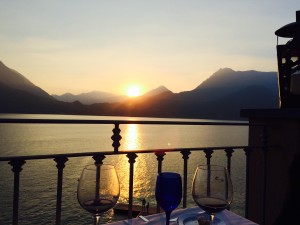
The following night, just about twenty yards down our ‘street,’ we found another sweet dinner table at Borgovino. They put us ‘out in the street,’ eh? (Do I detect a bottle of French Rosé from Provence on the dinner table? Shhhhh!
Villa Monastero
Of the many beautiful places here around what they call ‘mid-lake,’ we also spent an afternoon wandering the length of Villa Monastero, along the southern edge of Varenna. Here are a couple of images (that’s Lew at the top of the ancient stone stairs).
Moreno’s Cooking Class at Il Caminetto
Gretta and Rita spent an afternoon at Moreno’s cooking class up the hill at his restaurant. Il Caminetto is located on a winding one-lane road up the hill behind Varenna. They drive to Varenna’s town square to pick up their guests, because they don’t trust tourists to negotiate this road successfully (once you get on this road you can see why this is a wise decision). Moreno taught them everything one needs to know about tortellini.
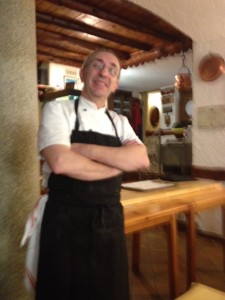 Click to hear a bit of Moreno’s Lesson about the history of Italian noodles (warning: it’s shocking).
Click to hear a bit of Moreno’s Lesson about the history of Italian noodles (warning: it’s shocking).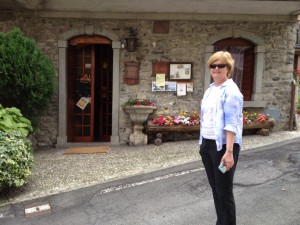
Rita, already a storied chef,
tries her hand at making tortellini.
And click here for a bit of Rita video:
Rita makes tortellini
And the product:
And, of course, Bellagio
The original Bellagio (not the fake one in Las Vegas) — just a fifteen-minute ferry ride across the water.
Lew & Rita (left) at lunch outdoors at Albergo Firenze in Bellagio; Gretta (right) expressing surprise at having wine from southern France (our next stop) here in Italy.
So, after five days, we say goodbye to Varenna and board a high-speed train to Antibes on the French Riviera. Our next installment of ConVivio will come from southern France.
See you there.
![]() Click to download a PDF of this post: Return_to_Varenna_ConVivio
Click to download a PDF of this post: Return_to_Varenna_ConVivio
